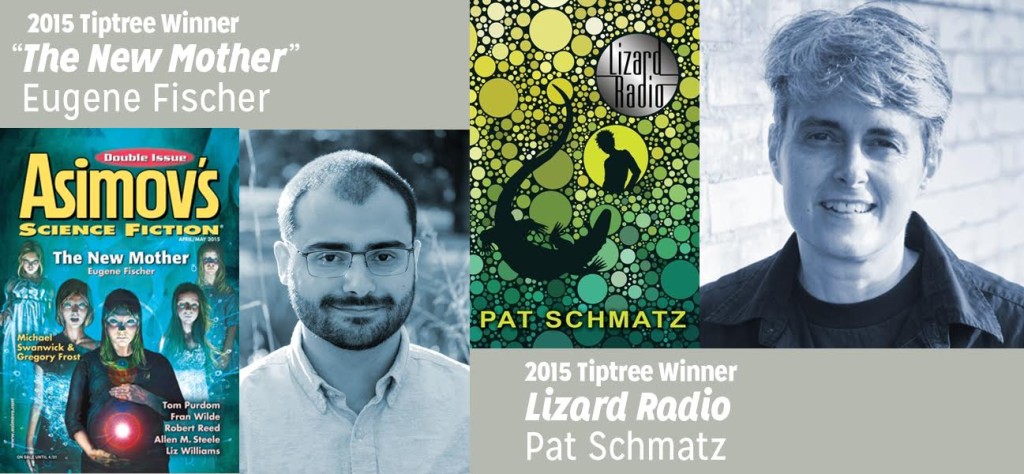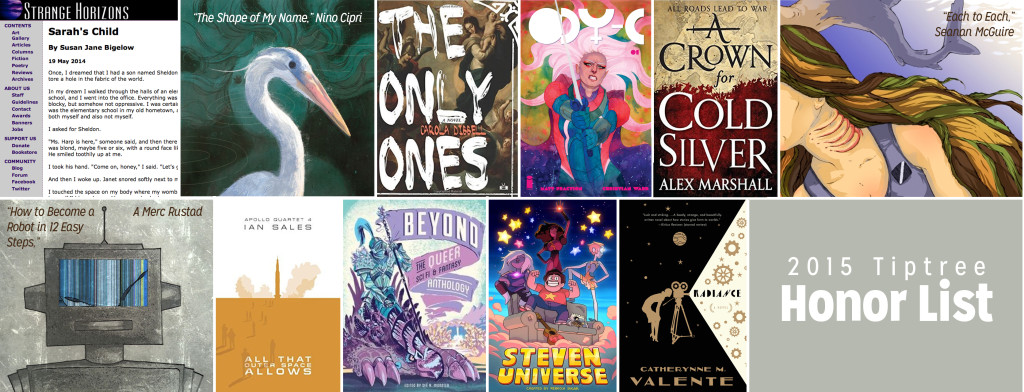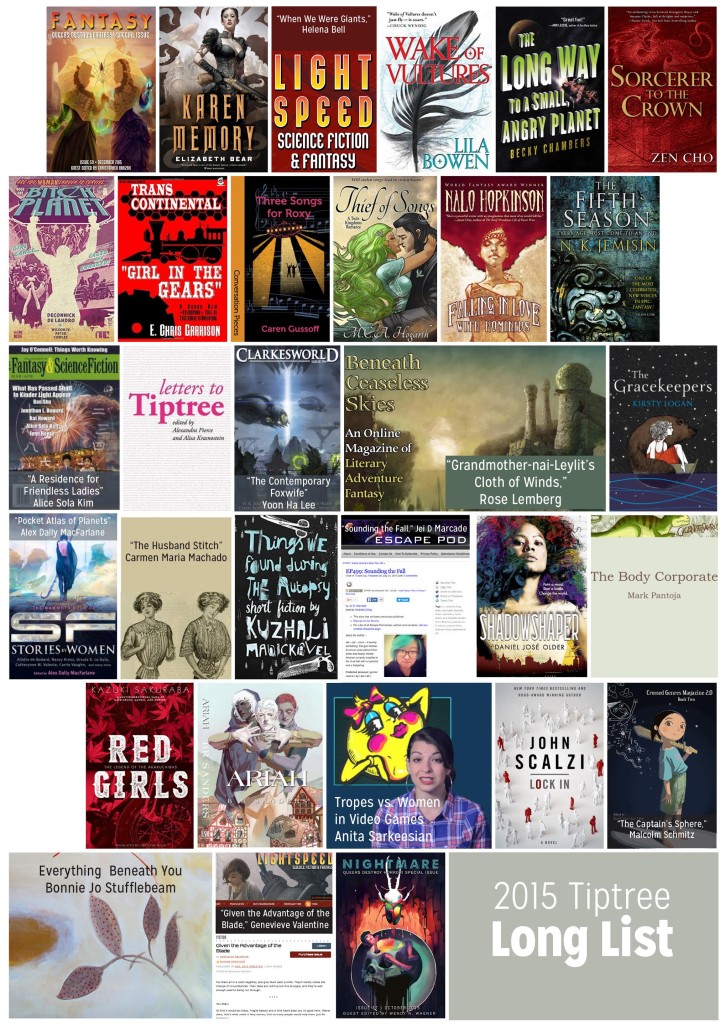The 2015 Tiptree Award winners, honor list, and long list have been selected. Our congratulations to Eugene Fischer and Pat Schmatz, this year’s winners!

Eugene Fischer, “The New Mother” (Asimov’s Science Fiction, April/May 2015)
While single-gender worlds are not new in science fiction, this is a rare consideration of the start of such a transformation, by way of a sexually transmitted disease that renders the infected person’s gametes diploid. For men, the result is infertility. For women, the result is the capacity to reproduce asexually: spontaneous pregnancies (unless they take a hormonal contraceptive) of genetically identical clones. As the story guides readers through the initial outbreak via journalistic and personal lenses, a range of reactions is highlighted: legislative action, scientific study, religious outrage, and burgeoning panic. This is a timely story, given the current political climate in the United States (where the story is set) with increasingly invasive attempts to police bodies across gender lines.
Pat Schmatz, Lizard Radio (Candlewick, 2015)
Kivali gives voice to the frustration often felt by children and young adults who do not “fit” as either male or female. In this dystopian society, children are given gender tests at an early age and then trained to live as the gender they tested for. Aspects of this world, for example, post-decision gender training, speak of the lived experience of many trans people forced to earn their transition by acting as female/male as possible. The book also points out the pitfalls of a codified, binary, externally decided approach to transgender lives when there are always people who fall outside of these expectations. Some of the mysteries of this world remain unexplained to the reader just as they are unanswered for Kivali, who finds her independence when a sudden upheaval in her life leads to a choice of conforming or forging her own path.
Honor List

In addition to selecting the winner, each jury chooses a Tiptree Award Honor List. The Honor List is a strong part of the award’s identity and is used by many readers as a recommended reading list. We are especially delighted that this year’s Honor List includes graphic novels and a television show, as well as written fiction. Honor List items (in alphabetical order by the author’s or creator’s last name) are:
Susan Jane Bigelow, “Sarah’s Child” (Strange Horizons, 19 May 2014)
A story of getting to see what happened on the path not chosen and having the chance to evaluate whether the original choice was the right one. Sarah dreams of the child she cannot bear in her assigned-male-at-birth body and struggles with her deep sense of grief. In a parallel universe she’s able to breach, Sarah’s son has an alternate mother, a woman born with a womb, but without the strength to come out to her family. Sarah and June—two women with the same identity, albeit in different bodies—each learn from the other how to be a more courageous version of themselves.
Nino Cipri, “The Shape of My Name” (Tor.com, 4 March 2015)
This quiet story of trans identity is tender and beautifully written, but does not pull its punches in terms of the personal hypocrisies of the characters, the compromises they make, or the ways that cruelty and pain are tied to the riskiness of love (and time travel). The relationship between the viewpoint character and their mother, in particular, is beautifully (if painfully) nuanced.
Carola Dibbell, The Only Ones (Two Dollar Radio 2015)
Told from the point of view of a young woman supporting herself through medical experimentation, the novel is thoughtful and astute in the way it explores the nexus of social and economic power with technology, racism, and sexism. It has important things to say about the way women’s bodies are treated as resources by institutions that exploit them for economic and political gain, and the ways in which desperate and disempowered women are forced into dangerous collaborations with their oppressors.
Matt Fraction (writer) and Christian Ward (artist), ODY-C, Vol. 1: Off to Far Ithicaa (Image 2015)
It’s the aftermath of a galactic war and instead of Odysseus, we have Odyssia and her crew. This is not the first time Homer’s Odyssey has been retold; the gods are still as meddlesome and trying as ever and the heroine’s journey home is still set to take years. What compels readers to return is the combination of non-linear storytelling and arresting visuals that complement the gender-flipped characters and their struggles against cosmic forces greater than themselves.
Alex Marshall, A Crown for Cold Silver (Orbit 2015)
A rollicking epic adventure with an appealing older female main character who clearly has issues beyond just dealing with whomever is trying to kill her and an extended (and extensive) cast who slowly wind their way through this world to band together. It upends most of the usual gender tropes one would find in the sprawling fantasy category, with women as likely as men to be in any particular role, and sexuality not particularly defining of anything except who you’re attracted to.
Seanan McGuire, “Each to Each” (Lightspeed, June 2014, Women Destroy Science Fiction!)
A post-humanist analogy of weaponized femininity, where essentialist notions of gender are deployed by a patriarchal military structure looking for the perfect soldier in a particular niche. The unintended result is a women-centered subculture with the power and opportunity to strike out on their own, for those with the inclination and independence to trade some of the trappings of humanity for that freedom. It’s a fascinating, nuanced, and furious exploration of a range of ideas around women and beauty, the military, body modification, and loyalty.
A Merc Rustad, “How to Become a Robot in 12 Easy Steps” (Scigentasy, March 2014)
A poignant and wry account of Tesla’s experience of mental illness and body dysmorphia that manages to weave together their experiences of depression, neuroatypicality, asexuality, and their desire for (and to become themself) a robot. The light but genuinely touching and hopeful ending balances the emotional and mental struggles they live through on the way.
Ian Sales, All That Outer Space Allows (Whippleshield, 2015)
This novel postulates an alternate 1960s America where science fiction is written and read almost exclusively by women, even though the space race is still a male-dominated field. In addition to serving as a meditation of what this means to a woman science fiction writer who is married to an astronaut in that alternate world, the book also reminds us of the women writers or our past through the main character’s fictional correspondence with her real science fiction writer contemporaries.
Taneka Stotts and Sfé Monster, editors, beyond: the queer sci-fi and fantasy comics anthology (Beyond Press, 2015)
A wide-ranging and entertaining collection of comics with queer characters, in which readers meet intentional and found families, dragon slayers, adventurers of all stripes, and robots deciding who they are going to be.
Rebecca Sugar (creator and executive producer), Steven Universe (Cartoon Network, 2013-15)
In the context of children’s television, this show deals with gender in a much more open and mature way than is typical for the genre, and has some of the best writing of any cartoon. Steven is a boy who is kind, caring, and whose magical skill (which he has inherited from his late mother) is that of protection. In addition to showing men and women who do not necessarily conform to standard American gender ideals, the show also gives us an agender/non-binary character and a thoughtful exploration of growing up through Steven and his friend Connie.
Catherynne M. Valente, Radiance (Tor, 2015)
Set in an alternate solar system in which life thrives on every planet in the solar system, space travel is relatively easy, and patent laws have restricted most films to remain silent, Radiance tells the story of a filmmaker who vanished during principle photography of her last film. Reading like a documentary in novel form, the book is written as transcripts, scenes from the woman’s own films, and fictionalized accounts of her life as told by her father (both before and after her loss). Radiance explores a universe in which film did not abandon women along with title cards.
Long List

Some juries choose to compile a “long list” of other works they want people to be aware of. Here is this year’s (extra-long!) long list:
- Christopher Barzak, Liz Gorinsky, and Matthew Cheney, editors, Queers Destroy Fantasy! (Fantasy, December 2015)
- Elizabeth Bear, Karen Memory (Tor, 2015)
- Helena Bell, “When We Were Giants” (Lightspeed, November 2015)
- Lila Bowen, Wake of Vultures (Orbit, 2015)
- Becky Chambers, The Long Way to a Small, Angry Planet (Harper, 2015)
- Zen Cho, Sorcerer to the Crown (Ace, 2015)
- Kelly Sue DeConnick (writer) and Valentine De Landro (artist), Bitch Planet, Vol. 1: Extraordinary Machine (Image, 2015)
- E. Chris Garrison, Girl in the Gears (CreateSpace, 2015)
- Caren Gussoff, Three Songs for Roxy (Aqueduct, 2015)
- M.C.A. Hogarth, Thief of Songs (De La Torre, 2015)
- Nalo Hopkinson, Falling in Love with Hominids (Tachyon, 2015)
- N. K. Jemisin, The Fifth Season (Orbit, 2015)
- Alice Sola Kim, “A Residence for Friendless Ladies” (Fantasy & Science Fiction, March/April 2015)
- Alexandra Pierce and Alisa Krasnostein, editors, Letters to Tiptree (Twelfth Planet, 2015)
- Yoon Ha Lee, “The Contemporary Foxwife” (Clarkesworld, July 2014)
- Rose Lemberg, “Grandmother-nai-Leylit’s Cloth of Winds” (Beneath Ceaseless Skies, 11 June 2015)
- Kirsty Logan, The Gracekeepers (Crown 2015)
- Alex Dally MacFarlane, “Pocket Atlas of Planets” (Interfictions, November 2015)
- Carmen Maria Machado, “The Husband Stitch” (Granta, 27 October 2014)
- Kuzhali Manickavel, Things We Found During the Autopsy (Blaft, 2014)
- Jei D. Marcade, “Sounding the Fall” (Escape Pod, 20 July 2015)
- Daniel José Older, Shadowshaper (Levine 2015)
- Mark Pantoja, “The Body Corporate” (GigaNotoSaurus, 1 September 2015)
- Kazuki Sakuraba, Red Girls: The Legend of the Akakuchibas (Haikasoru 2015)
- B.R. Sanders, Ariah (Zharmae 2015)
- Anita Sarkeesian, Tropes vs. Women in Video Games (Feminist Frequency 2013-15)
- John Scalzi, Lock In (Tor 2015)
- Malcolm A. Schmitz, “The Captain’s Sphere” (Crossed Genres, December 2015)
- Bonnie Jo Stufflebeam, “Everything Beneath You” (Beneath Ceaseless Skies, 8 Jan 2015)
- Genevieve Valentine, “Given the Advantage of the Blade” (Lightspeed, August 2015)
- Wendy N. Wagner, Megan Arkenberg, and Robyn Lupo, editors, Queers Destroy Horror! (Nightmare, October 2015)
Jurors
Each year, a panel of five jurors selects the Tiptree Award winner. The 2015 jurors were Heather Whipple (chair), Jacqueline Gross, Alessa Hinlo, Keffy M. Kehrli, and N.A. Sulway.
